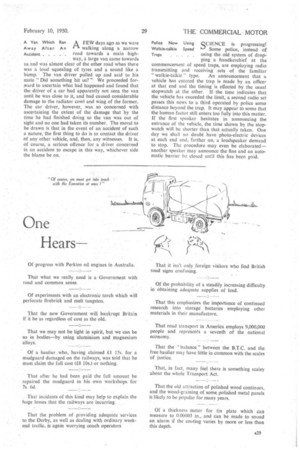One Hears-
Page 31

If you've noticed an error in this article please click here to report it so we can fix it.
Of progress with Perkins oil engines in Australia.
That what we really need is a Government with road and common sense.
Of experiments with an electronic torch which will perforate firebrick and melt tungsten.
That the new Government will bankrupt Britain if it be as regardless of cost as the old.
That we may not be light in spirit, but we can be so in bodies—by using aluminium and magnesium alloys.
Of a haulier who, having claimed El 15s. for a mudguard damaged on the railways, was told that he must claim the full cost (ES 10s.) or nothing.
That after he had been paid the full amount he repaired the mudguard in his own workshops for 7s. 6d.
That incidents of this kind may help to explain the huge losses that the railways are incurring.
That the problem of providing adequate services to the Derby, as well as dealing with ordinary weekend traffic, is again worrying coach operators
That it isn't only foreign visitors who find British road signs confusing.
Of the probability of a steadily increasing difficulty in obtaining adequate supplies of lead.
That this emphasizes the importance of continued research into storage batteries employing other materials in their manufacture.
That road transport in America employs 9,000,000 people and represents a seventh of the national economy.
That the balance" between the B.T.C. and the free haulier may have little in common with the scales of justice.
That, in fact, many feel there is something scaley about the whole Transport Act.
That the old attraction of polished wood continues, and the wood-graining of some polished metal panels is likely to be popular for many years.
Of a thickness meter for tin plate which can measure to 0.00003 in., and can be made to sound an alarm if the coating varies by more or less than this depth.




















































































